A New Way to Begin Flute
New Beginner Instruments Offer New Options
by Howard Fosdick © FolkFluteWorld.com
Do you remember your very first musical instrument? For most of us, it was a recorder.
Since the advent of the plastic recorder decades ago, American schools have focused on that instrument to introduce primary and middle schools students to music. The recorder is a natural for the role: it's child-safe, inexpensive, lightweight, durable, versatile, and easy to play.
In short, it's everything schools require for effective introductory musical education.
But the venerable recorder no longer occupies its perch unchallenged. Several companies have introduced innovative instruments into the educational market.
New Kinds of Beginner Flutes
For budding flute players, a company called Nuvo Instrumental has introduced three new plastic flutes. These are their TooT, jFlute, and Student Flute.
The TooT is designed as a beginner flute to compete with the recorder. The difference is that the Toot is specifically designed to lead youngsters to the concert flute.
This article reviews Nuvo's three new flutes. Are they better than recorders for beginners?
The TooT
This pre-band flute comes as a complete package. For about $30, you get:
- A TooT
- Carrying case with zipper
- Instructions with fingering chart
- Two interchangeable mouthpieces -- one flute-like, and the other recorder-like
- A link to free download of a complete educational package (a 50-page instructional book, plus over 100 video and audio files)
The instrument ships in a very sturdy box that renders any chance of shipping damage minimal. I kept the box in case I ever need to pack the flute for travel or storage.
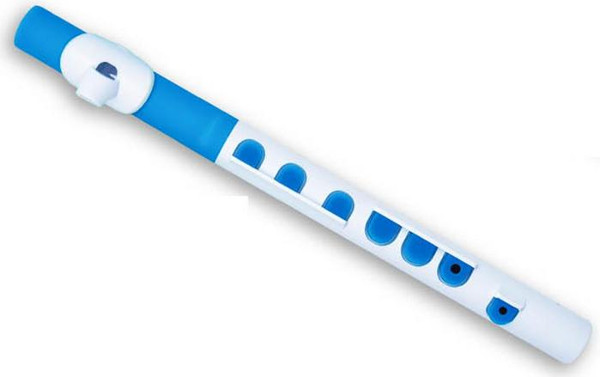
The Nuvo TooT (Image courtesy Nuvo Instrumental)
Designed for Children
The TooT meets all the same basic educational requirements as the recorder. It is child-safe, inexpensive, lightweight, durable, versatile, and playable. It's washable, too. It's available in a range of dual-color schemes. Younger children might be attracted to the brighter color schemes like green and white, or blue and white. Older ones may prefer the more "professional" or "adult" look of black plastic.
The TooT comes as a complete educational package. A link at Nuvo Instrumental lets you download a file that contains a 50-page instructional booklet. With it comes over 100 files that include 6 video lessons and 100 audio files (including backup tracks). Many youngsters need more than just a physical instrument to succeed, and Nuvo provides that in this included download.
The TooT is specifically designed for grade school children. Nuvo's jFlute and Student Flute address older students. For teachers, all the Nuvo instruments fit into a comprehensive educational curriculum called WindStars. You can find all the details at the WindStars website.
Sound & Playability
The TooT has a pleasant tone. It's not overbearingly loud like some small flutes. (A big plus if you're buying this for your child, a huge plus if you're a teacher.)
Played well, the TooT sounds more like a flute than a recorder or plastic whistle. It resembles a flute both in looks and sound.
Here are some Youtube videos that demonstrate how the TooT sounds.
The TooT is lightweight and comfortable for small hands. Its plastic keypads make it a little easier to cover the holes than the keyless recorder. This might be helpful for the youngest students. The design seems ergonomically sound.
The TooT has a range of 12 whole notes (C5 to G6), plus all sharps and flats in its range. Immediately out of the box, I was able to hit the full range of notes. (Perhaps I require more practice, but low C# voices only weakly.)
The fingering for all the whole notes mimics the flute more closely than the recorder, which is exactly what you want in a pre-flute instrument. I've excluded the chromatics from this chart to show the basic fingering:
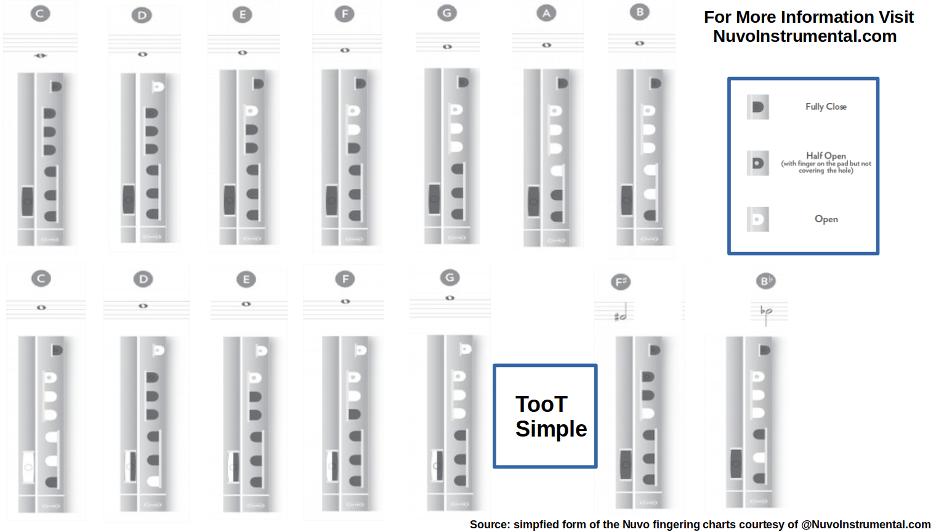
(Created from images courtesy of Nuvo Instrumental)
You can optionally remove the rubber centers from three of the finger hole covers -- those for the thumb and two rightmost fingers. This makes it easier to play some of the accidentals. The idea is to leave these hole covers intact for raw beginners, then remove them as students advance to playing the full chromatic scale.
It takes less wind to play a TooT than the much larger standard metal flute, and the instrument is way lighter. Both suit the young children this instrument is designed for. Plus, the Toot measures only 13" long. A subtle benefit of a smaller instrument is that it makes it easier to learn vibrato. A smaller instrument is more sensitive to more minute variations in breath pressure.
(An irrelevant disgression about fingering -- If you're experienced with other kinds of flutes, you can play the TooT with alternate fingerings. For example, you can finger much like a tin whistle and overblow to the upper octave. You can also keep your righthand pinky in the air and play most notes without covering that hole, thus mimicing German recorder fingering.)
Interchangeable Mouthpieces
The TooT's biggest advantage is that it comes with two interchangeable mouthpieces. A simpler, recorder-like fipple automatically directs the players breath into the lip of the flute to produce notes. Anyone can pick up a TooT and instantly play using this mouthpiece, just as easily they can play a recorder.
To learn fluting embouchure, you can pop out the fipple mouthpiece and replace it with the flute-like mouthpiece. Now you must direct your breath properly across a lip plate to play, just as you must with a concert flute.
The two mouthpieces allow students to learn embouchure at their own pace. They can play immediately with the fipple. If they inspect the fipple, they can see exactly where they'll have to direct their breath to play with the lip plate mouthpiece. This is a clever way to help young students approach proper flute embouchure.
Here are the two swappable mouthpieces:

Two Swappable Mouthpieces (Image courtesy Nuvo Instrumental)
The jFlute
Beyond the TooT, Nuvo offers two more advanced plastic flutes: their jFlute and Student Flute.
The jFlute is a more sophisticated pre-flute than the TooT. It plays in three registers, features more realistic physical keying, and ranges across about three octaves. The fingering is the same as a standard concert flute. Like the TooT, it's keyed in C and supports all chromatics.
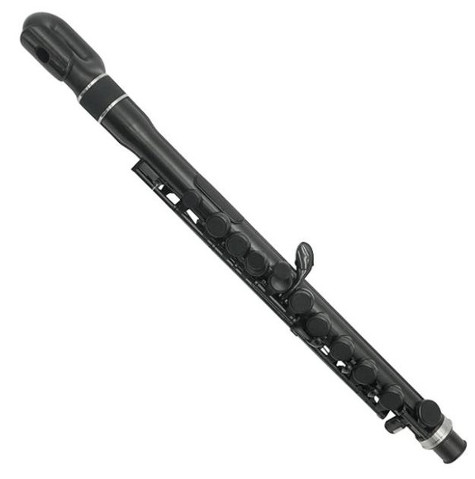
The jFlute (Image courtesy Nuvo Instrumental)
The jFlute is slightly longer than the TooT. It incorporates a "donut" head joint to add tube length and resonance without lengthening the instrument. The goal is to keep the instrument short and lightweight for all sizes of student.
The jFlute comes with the same exchangeable mouthpieces as the TooT. It is tunable and comes with D foot and removable key extensions. So a young person (or their tutor) can customize it to their preferences.
The jFlute challenges children with the greater complexity they'll face with a standard concert flute. In comparison to the TooT, it's definitely a more substantive, capable instrument. You can hear some jFlute sound samples here. It costs about $130.
Nuvo's Student Flute
Next in Nuvo's line-up is their Student Flute. The Student Flute is no pre-flute. It performs at a level that directly competes with metal flutes. So it is a quality plastic instrument that offers an alternative to metal student flutes. Some of its advantages include its lower weight (half that of a metal flute) and greater durability. At about $180, it costs much less than many serious metal flutes.
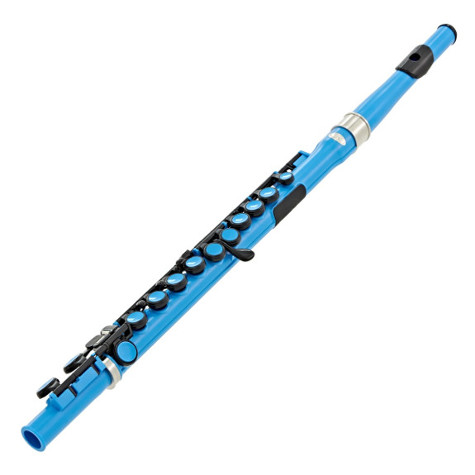
The Student Flute (Image courtesy Nuvo Instrumental)
TooT, jFlute, or Student Flute?
Of Nuvo's three new student flutes, which should you buy? It depends on the age of your child and how serious they are about playing an instrument. The TooT is the perfect toy / instrument for the absolute beginner. It's well designed for the youngest, with its small size, light weight, two mouthpieces, and removable finger plugs. (And yet, when you learn to play it, it can deliver a surprisingly enjoyable musical experience -- within its limited range.)
The jFlute is for more mature children who are ready to take on standard flute fingering across three registers, and all that implies.
The Student Flute is a full-on competitor to standard metal flutes.
A New Way to Begin Flute
For decades, American schools have introduced youngsters to music with recorders. Now there is an alternative for those who want to play flute.
As far as I know, Nuvo is the first to offer a pre-flute, rather than a generic "pre-woodwind." The TooT sounds like a flute and fingers like a flute. You play it at the same angle as a flute. With both lip plate and fipple mouthpieces, you can play it like a flute, too.
For another $100, the jFlute offers a big step up towards a real flute. It fingers the same as a concert flute and has the same pitch range. Yet it still retains some beginner advantages, such as the exchangeable mouthpieces. And lightweight, durable construction.
That both of these flutes are keyed in C means that they are key-compatible with recorders and most other inexpensive plastic flutes. So students can download tons of free music from the internet.
Before I bought a TooT, my off-hand impression was that it looked a high-quality preband competitor to the recorder. And that Nuvo was charging a full price for it in consequence.
Now that I've worked with it, I see it differently. The TooT is a true pre-flute, not just a modified recorder. The scope of the free downloads that accompany it -- some 240 megabytes as a compressed file -- means that Nuvo gives you an entire educational package, not just an instrument. And it fits into a solid teaching curriculum. This is a very good value for the price. The jFlute offers a big step up without committing the finances many good concert flutes demand.
For children who express interest in playing the flute, the TooT and jFlute may be more suitable places to start than the recorder.
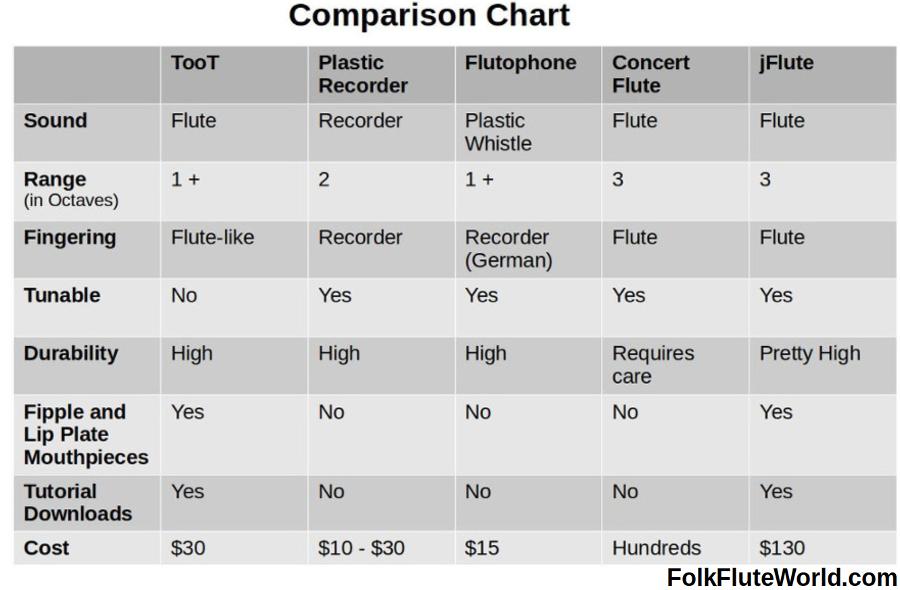
Comparison Chart for TooT, jFlute, Recorder, Concert Flute, and Flutophone